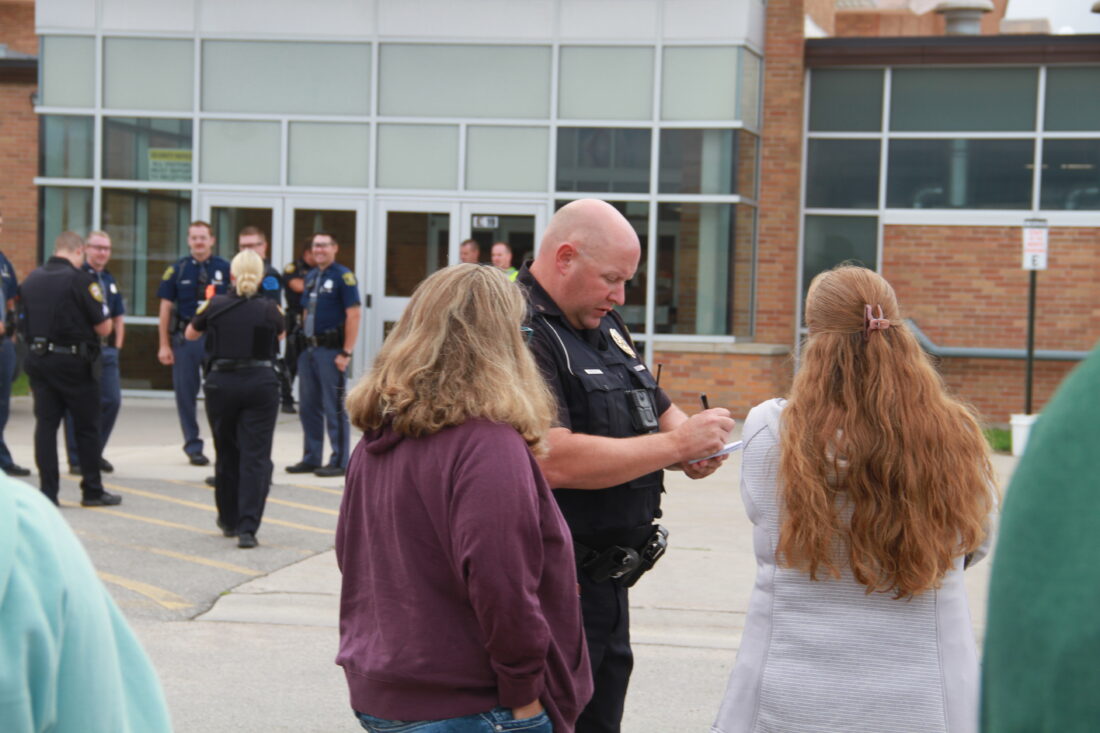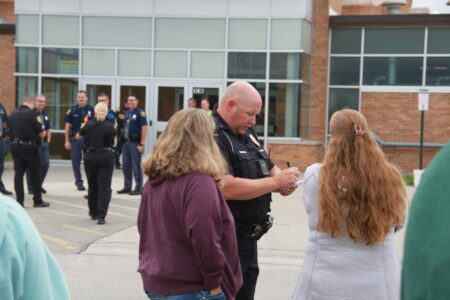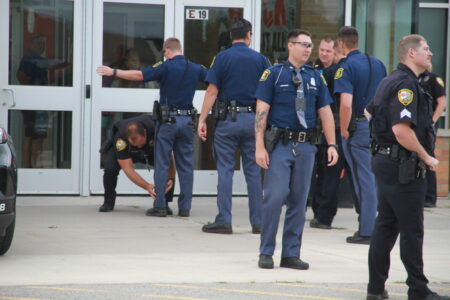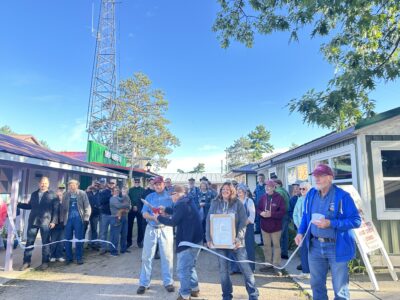Drill tries to prepare for potential school shooting
- Sergeant Joshua Meyette of Escanaba Public Safety gathers information from people who had been in the cafeteria of the Escanaba Junior/Senior High School when the mock “shooter” appeared during an emergency drill on Wednesday morning. In the background, other EPS officers, along with members of the Michigan State Police and Delta County Sheriff’s office, await orders. (R. R. Branstrom | Daily Press)
- Officers wait to be granted access to the Escanaba Junior/Senior High School during an active shooter drill Aug. 20. They were allowed into the building gradually, to simulate various arrival times that would occur in a real scenario. (R. R. Branstrom | Daily Press)

Sergeant Joshua Meyette of Escanaba Public Safety gathers information from people who had been in the cafeteria of the Escanaba Junior/Senior High School when the mock "shooter" appeared during an emergency drill on Wednesday morning. In the background, other EPS officers, along with members of the Michigan State Police and Delta County Sheriff's office, await orders. (R. R. Branstrom | Daily Press)
ESCANABA — A drill to prepare first responders and schools for an event they hope never occurs took place last week at the Escanaba Junior/Senior High School.
Designed to simulate an active shooter situation, the mock event placed people inside the building — which, at the time of the drill Aug. 20, was not yet open for the school year — who were given various instructions but little detail about what to expect.
“This drill is intended to help schools and first responders test and refine emergency plans and procedures in a realistic scenario,” an Escanaba Area Public Schools district news release advised before the drill.
One selection of participants was told to flee when the “shooting” began; another group was told to freeze in place; a third was told to hide.
“We know, practically speaking, that during the day we’ll have people in the commons, we’ll have people in the cafeteria, we’ll have people in hallway, we’ll have people in offices,” said Superintendent Coby Fletcher, standing outside in the parking lot while the drill went on. “Experience has shown that (the people in the commons and hallway spaces) will run for the doors, which is what they should be doing.”

Officers wait to be granted access to the Escanaba Junior/Senior High School during an active shooter drill Aug. 20. They were allowed into the building gradually, to simulate various arrival times that would occur in a real scenario. (R. R. Branstrom | Daily Press)
He said that in the past, procedure used to be for people to barricade themselves in classrooms and hide, but that staff and students remaining on premises with an active shooter creates the potential for them to become additional victims.
The new protocol is “run, hide, fight” — evacuate if possible; find a safe and silent hiding place as a second alternative and, as a last resort, if your life is in immediate danger, take action to incapacitate the aggressor.
The problem with fleeing aimlessly is that it creates confusion when trying to account for people afterwards, leading parents and others to panic and wonder whether their loved ones are safe, trapped or worse. For this reason, a reunification plan is established: survivors who manage to escape the scene are to gather at a prearranged destination to check in.
“It’s revolting that we have to plan for tragedies like this,” one community member said afterwards. “But unfortunately, guns are extremely prevalent, and it’s not hard for an unstable person to get their hands on one. In the U.P., you even have organizations who are trying to be charitable and yet they hand out firearms as prizes.”
However, with technology in place today at school entrances, it’s gotten more difficult — “nearly impossible,” Fletcher said — for someone with deadly intentions to gain access.
Practices like the ones Aug. 20 also help administration and emergency personnel prepare, anticipate, iron out problems and reformulate plans. A similar drill took place in August 2024 at Gladstone High School, and more will happen at other local schools in the future.
“While the overall goals were similar, each drill is unique to the layout of the school and the agencies involved,” said Escanaba Public Safety Sgt. Austin Young, who will become as captain Tuesday, when asked how the recent drill compared to the one in Gladstone. “The Escanaba scenario allowed us to focus more closely on challenges specific to EHS, such as building access points and traffic flow.”
Fletcher said that this particular type of drill is not conducted with students while school is in session, remarking that it went “very badly” for a couple districts that tried.
The exercise was a success, though, Young said. He stated that agencies are now better prepared.
The day after the event, those involved attended a debriefing in the school auditorium to discuss takeaways.
“We identified areas for improvement in communication between first responders and school personnel, and we were able to strengthen coordination on evacuation and reunification procedures. These lessons will directly improve preparedness,” Young said. “The partnerships between schools, law enforcement, fire, EMS, RTF (Delta County Rescue Task Force) and emergency management continue to grow stronger through these exercises.”
He said the Escanaba Public Safety Department was grateful to the school district and all agencies involved.
“The Escanaba Area Public Schools expresses its appreciation for the hard work and effort of Escanaba Public Safety to plan and organize this drill scenario, which is part of a mission towards strengthening valuable partnerships that help ensure a safe, secure environment for students and staff,” read a statement from the district.
“Regular training like this ensures that if a real emergency occurs, our community is better protected,” Young concluded.




